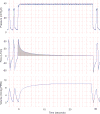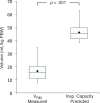Volume Delivered During Recruitment Maneuver Predicts Lung Stress in Acute Respiratory Distress Syndrome
- PMID: 26474111
- PMCID: PMC5224862
- DOI: 10.1097/CCM.0000000000001355
Volume Delivered During Recruitment Maneuver Predicts Lung Stress in Acute Respiratory Distress Syndrome
Abstract
Objective: Global lung stress varies considerably with low tidal volume ventilation for acute respiratory distress syndrome. High stress despite low tidal volumes may worsen lung injury and increase risk of death. No widely available parameter exists to assess global lung stress. We aimed to determine whether the volume delivered during a recruitment maneuver (V(RM)) is inversely associated with lung stress and mortality in acute respiratory distress syndrome.
Design: Substudy of an acute respiratory distress syndrome clinical trial on esophageal pressure-guided positive end-expiratory pressure titration.
Setting: U.S. academic medical center.
Patients: Forty-two patients with acute respiratory distress syndrome in whom airflow, airway pressure, and esophageal pressure were recorded during the recruitment maneuver.
Interventions: A single recruitment maneuver was performed before initiating protocol-directed ventilator management. Recruitment maneuvers consisted of a 30-second breath hold at 40 cm H2O airway pressure under heavy sedation or paralysis. V(RM) was calculated by integrating the flow-time waveform during the maneuver. End-inspiratory stress was defined as the transpulmonary (airway minus esophageal) pressure during end-inspiratory pause of a tidal breath and tidal stress as the transpulmonary pressure difference between end-inspiratory and end-expiratory pauses.
Measurements and main results: V(RM) ranged between 7.4 and 34.7 mL/kg predicted body weight. Lower V(RM) predicted high end-inspiratory and tidal lung stress (end-inspiratory: β = -0.449; 95% CI, -0.664 to -0.234; p < 0.001; tidal: β = -0.267; 95% CI, -0.423 to -0.111; p = 0.001). After adjusting for PaO2/FIO2 and either driving pressure, tidal volume, or plateau pressure and positive end-expiratory pressure, V(RM) remained independently associated with both end-inspiratory and tidal stress. In unadjusted analysis, low V(RM) predicted increased risk of death (odds ratio, 0.85; 95% CI, 0.72-1.00; p = 0.026). V(RM) remained significantly associated with mortality after adjusting for study arm (odds ratio, 0.84; 95% CI, 0.71-1.00; p = 0.022).
Conclusions: Low V(RM) independently predicts high lung stress and may predict risk of death in patients with acute respiratory distress syndrome.
Conflict of interest statement
Copyright form disclosures: The remaining authors have disclosed that they do not have any potential conflicts of interest.
Figures




Comment in
-
Lung Protective Ventilator Strategies: Beyond Scaling Tidal Volumes to Ideal Lung Size.Crit Care Med. 2016 Jan;44(1):244-5. doi: 10.1097/CCM.0000000000001454. Crit Care Med. 2016. PMID: 26672934 No abstract available.
References
-
- Gattinoni L, Caironi P, Cressoni M, et al. Lung recruitment in patients with the acute respiratory distress syndrome. N Engl J Med. 2006;354:1775–1786. - PubMed
-
- Maunder RJ, Shuman WP, McHugh JW, et al. Preservation of normal lung regions in the adult respiratory distress syndrome. Analysis by computed tomography. JAMA. 1986;255:2463–2465. - PubMed
-
- Gattinoni L, Mascheroni D, Torresin A, et al. Morphological response to positive end expiratory pressure in acute respiratory failure. Computerized tomography study. Intensive Care Med. 1986;12:137–142. - PubMed
-
- Gattinoni L, Caironi P, Pelosi P, et al. What has computed tomography taught us about the acute respiratory distress syndrome? Am J Respir Crit Care Med. 2001;164:1701–1711. - PubMed
-
- Gattinoni L, Pesenti A, Avalli L, et al. Pressure-volume curve of total respiratory system in acute respiratory failure. Computed tomographic scan study. Am Rev Respir Dis. 1987;136:730–736. - PubMed
Publication types
MeSH terms
Grants and funding
LinkOut - more resources
Full Text Sources
Other Literature Sources

